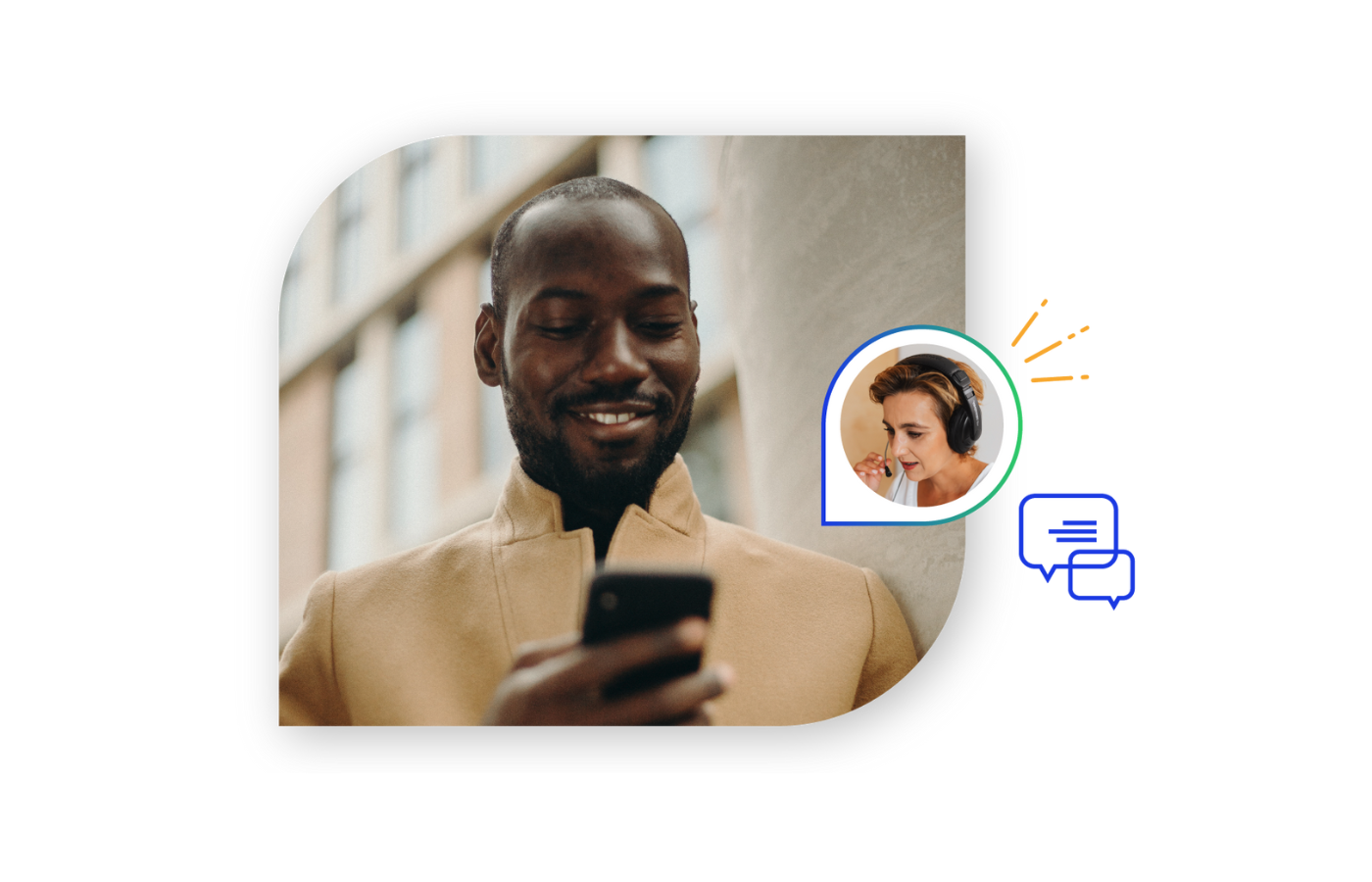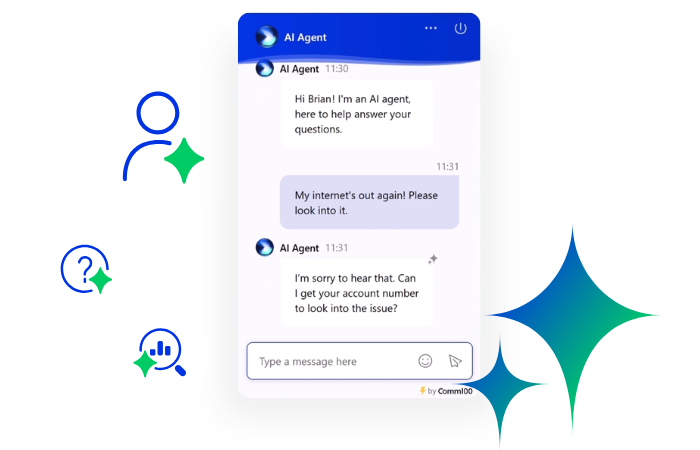You’ve considered and perfected your agents’ on-camera appearance… congratulations! They’re looking professional and are ready to tackle a one-on-one video chat without disturbances.
However, as the saying goes, looks aren’t everything. Your agents might be naturally glowing from a great night’s worth of beauty sleep, and/or following the company dress code to a T. But what will that matter if your agents are extremely backlit, and their faces are impossible to see? What about if your agents have their backs to the bathrooms, and your customers are watching people come and go behind them mid-chat? Or if your customers can’t focus on their representatives, because they can hear every other word from the conversation another agent is having one cubicle over? How important will it really be that your agents look professional if the ambiance that they are working with is anything but?
All of these scenarios are possible if you haven’t made the proper picture, sound, and background considerations before launching your video chat channel. This blog post will go over these and other technical considerations, and give you tips for setting up the ideal video chat environment both in the office and at home.
Picture
Before your agents even say a word to your customers over video chat, the first images your visitors see are going to set the first impression of your company’s customer service. If your picture quality is good, your customers are more likely to have a good overall first impression of your video chat customer service. If your picture quality is poor, the opposite may very well happen, and your move to wow your customer with video chat could end up in a flop.
This is in part thanks to the halo effect – the way we tend to judge and experience one area due to our positive or negative experience with another. For example, if you visit a beautifully designed website that is extremely easy to navigate, you are more likely to assume that the content is also high-quality, even if that is not necessarily the case. On video chat, if your picture is clear and your audio is good, your customers are more likely to assume that your agents have their act together, and that they know what they are saying.
While it’s possible to get by with sub-par video quality, the quality of your interactions, level of your professionalism, and even customer acquisition may expand when you improve it.
The best way to go about upgrading your business video chat quality is by investing in an external webcam. External webcams have larger lenses than those which are built into your agents’ computers, and typically offer better resolution and high-definition video capabilities. Higher-end models even have automatic focusing, light correction, and stereo audio. They are available for as cheap as less than $20, with higher-end (but still affordable) models averaging at about $60. You can find TechRadar’s list of the top webcams of 2017 here.
External webcams also give you more control over camera positioning. Before your agents begin video chatting, the camera should be placed at or slightly above eye level. Even if your agents are working remotely from a laptop at home, they should make sure that their camera is high enough that they are not looking down at it (customers don’t want to have to see up your agents’ noses, and shouldn’t be able to tell that they are working from a laptop).
This also means making sure that agents who are based at home always place their computers at a table or a desk while talking with customers, rather than on the couch beside them, or in their laps (this angle is best reserved for video chatting with family and friends – for customer service it can easily result in an unprofessional image that can make your agent seem unqualified). On the flipside, also note that the camera shouldn’t be placed so high that it looks like your agents are trying to take a perfectly posed Instagram selfie.
Some picture issues may arise on your customers’ end if they have a bad internet connection. Although you can’t fix your customers’ connection issues, you can make sure that your company’s internet speed (or your agents’ home internet speed if they work remotely) is fast enough to seamlessly support video chat. That, coupled with quality webcams, will give your agents a crystal-clear picture, which will set your customers on track to having a superb video chat experience.
Sound
When setting up for video chat for business, your primary goal should be to replicate a quiet, private conference room. This can be difficult in a room full of agents who are chatting with customers (or even amongst themselves while waiting for their next call). For remote live chat agents, the challenge may be creating a private, silent space, where the noise from other members of the household will not be audible to customers.
Using a headset can minimize office (or other) noise, while also maximizing customer privacy. The visual impact of wearing a headset will be great for customer confidence too – if a customer is reading their card or account information to an agent, they are going to feel better knowing that only the agent can hear it.
Choose a headset with a built-in, external, noise cancelling microphone. This will offer better sound and will cut down on the background noise that your company computers are likely to pick up. Many headsets also have twistable mics, which your agents will be able to move closer or farther from their faces as needed to make sure that their voices are coming through clearly.
Using headphones also has the advantage of reducing speaker feedback. If your agents are not wearing headphones while chatting with customers, then their computer microphones might pick up the other person’s voice from the speakers and create a feedback loop, which would result in a distracting – not satisfying – customer service experience.
Remote live chat agents can opt for a traditional business headset, or a high-quality gaming headset may also do the trick. Bluetooth and hands-free varieties are also available starting at around $20.
To further reduce noise interference in video chat, consider adjusting agent placement. If not all of your agents are taking video calls, consider spacing out agents who are video chatting with agents who are typing to customers over regular live chat. This will minimize the noise, and increase the personalized, intimate feel of video chat for increased customer satisfaction.
Lighting
You may have your picture set up, but if your agents aren’t properly lit, then at best your video chat experience won’t be anything to write home about, and at worst your agents might end up not being visible at all. Like the elements before it, the right lighting is extremely important for setting the scene for video chat and can make or break your professional image.
Good video chat for business features a subject bathed in natural light that originates from behind the camera. Your agents should be front-lit – not back-lit or side-lit. If your agents have a light source behind them, their faces will be completely shadowed, and hard for your customers to see. If your agents’ light source is to their side, then half of their face will be cast in shadows, which doesn’t look much better.
When arranging your agents’ desks for video chat customer service, remember that you should never place agents with their backs or sides to a window, unless there is also a front-facing light that balances this out. You should also avoid seating your agents under fluorescent overhead lights. Sitting under a giant fluorescent light creates eye shadows and illuminates the face in a harsh, unsightly way. If you can help it, avoid industrial lighting all together in your office.
Consider placing a personal light source at each agent’s desk if your office has poor or uneven lighting. Like your webcam, make sure that this light is placed around eye-level; you should avoid up-lighting, unless you want your agents to look like extras in a horror film. If you use a lamp as your personal lighting source, make sure that the light is soft, rather than bright. You don’t want your agents to get a headache from staring into a bright light, and this may also dramatically over-illuminate their faces. Instead, look for ways that you can diffuse any direct light.
Here’s an example of how remote agents working from home during daylight hours might accomplish this: Instead of sitting directly in front of an open window, use a sheer curtain to diffuse the light, so that it does not look so bright on your agents’ faces. You can accomplish this for your video chat agents in-office by using a lamp with a shade, by pointing lamps down at the desk instead of directly in your agents’ faces, or by installing soft white lights. If a light needs additional diffusing, try experimenting with using strategically placed white fabric (placed in front of the light while taking care to avoid a fire hazard) or diffusing paper.
If one light source isn’t doing the trick, add another one as necessary. Multiple sources of diffused light can do wonders for video chat. You may also want to consider painting cubical walls white, or covering them in diffusing paper, white poster board, or another semi-reflective white surface. By aiming light away from your agents and towards this surface, the light reflects, or bounces, off that surface and creates a secondary source of light, which will illuminate your agents with diffused light.
Don’t forget to aim for lightbulbs that emit a natural, neutral white light. Avoid colors that are too cool (this will look cold and industrial) or too warm (you want your video chat to look professional, not like a bedtime reading session). Make sure that your lighting is easily replicable, or even better, that you can create a fixed setup so that your agents do not have to adjust this before every video call.
Powerful live chat software
Offer real-time, personalized, efficient support that your customers and agents will love at 1/3 the cost of voice support.
Learn more
Comm100 Live Chat
Background
Whether it’s the awkward girl stuck in the camera shot, or the little boy struggling to get out of his life vest in the backdrop of a news report, some of the greatest bloopers are born when video backgrounds go wrong.
While these missteps make for great YouTube videos and GIFs, they should be avoided in customer service situations. A distracting background can cause a customer to tune out their live chat agent, or make a customer lose track of what they themselves were saying. It can delay resolution and increase your company’s average handle time. It can give the customer the impression that your company doesn’t take its video chat customer service seriously, and even worry them about privacy issues.
You can avoid background distractions by considering agent placement for video chat. Don’t set up your agents where there is a lot of traffic behind them, as this will be very distracting and possibly even disturbing to your customers. Instead, consider introducing more closed-off cubicles for agents who are video chatting, so that the background is a cubicle wall. This way, other agents passing who are passing by will not show up on screen.
Whether your backdrop ends up being a cubicle wall or another undisturbed company wall, we recommend that you take a minimalistic approach to what is behind your agents. Think of the background as part of the visual story that you are telling: you want it to be professional, not cluttered or chaotic. If you have a company color, consider using this on a background wall for a really clean, on-brand look. Agents who work at home may not want to do this, but for small video chat operations in the office, where practical, this is a nice touch.
Remote video chat agents should also strive for a professional setup – wherever possible, customers should not know that their agent is working from home. Consider encouraging remote agents to also adopt a plain wall as a background to create a neutral, office-like setting. While remote agents may not have to worry so much about people walking by in the background, encourage them to lock their office doors and/or avoid having an entryway in the background so that unsuspecting family members don’t barge in on their video chat, as was the case in the widely popular video of the BBC reporter whose kids interrupted his live at-home correspondence.
Whether your agents are at the office or at home, encourage them to take care to avoid clutter and piles of anything sort (papers, books, etc.) that may be visible to the camera. Video chat agents should also keep out of sight any items that might need an explanation, including anything that advertises a brand, team, or place that doesn’t directly correspond with the company. For example, a live chat agent taking video calls in the office might want to make sure that their sports team bobble head is out of sight, and an agent working remotely should avoid having any bedroom movie posters visible in the backdrop.
If you’re not sure whether or not to allow something in the background, ask yourself: is it inconspicuous? Is it professional and/or consistent with your brand image? Does it keep your customer’s focus on the agent and the task at hand?
Conclusion
Movies are a multi-billion dollar industry – but imagine who would be able to watch, let alone take films seriously, if directors didn’t account for the lighting, sound, picture, and background?
Video chat is the same way. If you want to give your customers a quality, engaging, and professional video chat experience, then you need to take the same visual and audio elements into consideration.
These sound and background considerations can be used by businesses, customer service managers, freelance agents, or even individuals who are preparing for a video interview. We hope that these considerations for professional video chat will help your team (or just you!) look like a group of seasoned video chat experts – not first-timers.
For additional reading, check out our blog post, 12 Ways that Audio and Video Chat Wins Customer Service.
Download now: The Guide to Becoming a Top Performing Live Chat Agent
Better communication allows you to help customers set right expectations, which is an essential skill for agents to be top performing. Here we offer 12 essential tips for live chat agents to communicating effectively, addressing customer issues efficiently, and representing your brand professionally.
Download now
eBook








